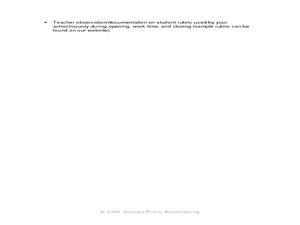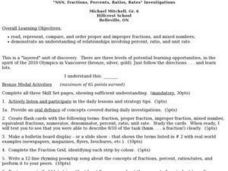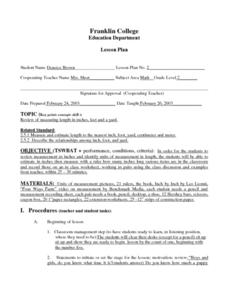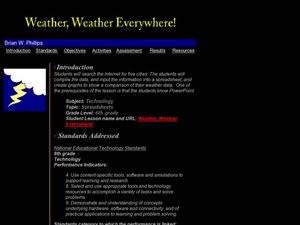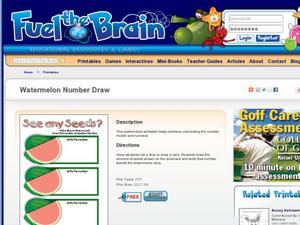Illustrative Mathematics
Watch out for Parentheses
It is important for the algebra learner to understand the use of parentheses. Mathematicians of all levels can make errors with nested parentheses. This will give them some practice. It makes for a good class starter or quick assessment.
Curated OER
Scatter Brain
Examine a coordinated geometry grid to decode the hidden message. Pupils write a coded message to their parents using letter coordinates from the grid.
Illustrative Mathematics
Zeroes and factorization of a quadratic polynomial I
This activity uses the division algorithm and the definition of a zero/root of a function to guide your class to see the relationship between zeros and factors of a general quadratic, which can later be generalized to the Remainder...
Curated OER
Graphing It Daily
Students identify and demonstrate a positive learning attitude and use basic concepts and skills. Learners also communicate clearly in oral, artistic, written, and nonverbal form. Finally, students participate in the daily data...
Curated OER
Integers
Students explore integers through a review of basic knowledge and understanding of integers. They order integers on a number line and evaluate integer expressions with variables. Students order values from variable expressions on a...
Curated OER
Accounting/ Marketing Cookies
Second graders become involved in the advertisement, marketing, and development of their own cookie business. Students must choose a job for the preparation and baking of the cookies. Students also manage the profits and advertisement of...
Curated OER
Subtracting With the Hundreds Place And Regrouping
Learners solve math problems involving subtracting with regrouping. They practice the steps for subtracting in the hundreds place with regrouping, through teacher guided practice. Independently, pupils complete story problems involving...
Curated OER
The Weight of Primates
Second graders practice their problem solving skills. For this addition and subtraction skills lesson, 2nd graders solve word problems that require them to find differences and sums. This lesson features the use of a video titled...
Curated OER
Working with Percentages
Students complete basic operations using percentages in a variety of real world situations. Discounts are computed and compared to a variety of prices listed in local newspaper advertisements.
Franklin College
Tell Time to the Nearest Half-hour and Relate to Events
Youngsters examine how to tell time to the nearest half-hour. They discuss why people wear watches, listen to the book "What Time Is It?" by Sheila Keenan, view examples on a model clock, and complete a worksheet with the teacher.
Curated OER
Volume of a Rectangular Prism
Children use the length, width, and height of an object to calculate the volume of a rectangular prism. They observe how to multiply three numbers at a time, and define volume. Pupils observe as the teacher demonstrates how to determine...
Curated OER
"NSN, Fractions, Percents, Ratios, Rates" Investigations
Sixth graders engage in an investigation about the concepts related to fractions. They read, represent, compare, and order proper and improper fractions, and mixed numbers. They demonstrate an understanding of relationships involving...
Curated OER
Measurements - Franklin College
Second graders review measurements in inches and practice measuring different objects. As a class, they estimate various objects in their classroom and compare their estimation to the actual measurement. To end the lesson, they complete...
Curated OER
Quilting Geometry
Study geometry through the concept of quilt design. High schoolers examine the geometric shapes in various quilts and then create their own quilts using geometric shapes that fit together. In the end, they write a paragraph to describe...
Curated OER
Halves And Fourths
Young learners start out by going to the board to draw lines through shapes to identify halves. Then they are given a square of paper and are directed to fold the paper into halves and then into fourths. They color the halves and fourths...
Curated OER
The Pythagorean Theorem Lesson 2
Learners discuss and review examples of the Pythagorean Theorem using a GSP, Geometer's Sketchpad, activity.
Curated OER
Weather, Weather, Everywhere!
Sixth graders collect weather data to compare temperatures around the world. Using the Internet, learners collect data, put it into spreadsheets, and analyze and graph the results. An interesting way to cover the topic of weather.
Curated OER
See any Seeds?
Oh no! These watermelons have no seeds! Beginning counters use fun templates as they roll dice and draw the resulting number of seeds onto the watermelon image. They also write the number in the space beside the watermelon. Consider...
CCSS Math Activities
Scatter Diagram
Don't let a great resource scatter to the winds. Pupils analyze two sets of test scores on a scatter plot. They draw a line of best fit and use it to make predictions about the test scores. They also consider any apparent trends in the...
Curated OER
Geo Jammin' By DeSign - Day 1, Lesson 5: Do You Hear What I Hear?
Students listen to a poem that includes directions to use geometric figures to complete a creative task.
Curated OER
The Diagonal Of A Box
Students solve problems using the pythagorean theorem. They use critical thinking skills in order to use a systematic process to solve the problem. Upon solving each problem the uniqueness of the lesson is asking students to give an...
Curated OER
Creating a Bar Graph Using a Spreadsheet: Dice Rolling Probabilities
Tenth graders explore the concept of spreadsheets. They create a simple spreadsheet and chart from given data. Students perform basic formatting procedures on their chart. They use spreadsheet functions to perform calculations.
Curated OER
Transformations
Seventh graders complete activities to perform transformations of various figures and describe the transformations. In this transformations instructional activity, 7th graders perform a translation, a rotation, and a reflection on graph...
Curated OER
Time Lesson
Second graders observe a clock and discuss at what time of day they perform a certain task such as what time they wake up, go to sleep, etc. They use a clock and show what time they wake up in the morning differentiating whether it is...









